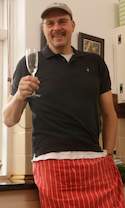Steenberg was then owned by Johnnies Industrial Corporation (Johnnie), which had developed this seventeenth-century farm into a multi-purpose luxury living and leisure resort. But besides the five-star boutique hotel, gourmet restaurants, and residential estate on a championship 18-hole golf course, there were the new vineyards.
Steenberg Vineyards

Established in 1990 with a view to fully exploiting the valley's emerging reputation as one of the expanding Cape Winelands' finest cool-climate sites, they comprised both classic reds and whites on some 60 hectares on the south-facing slopes of Steenberg Mountain.
When John Loubser came on board the range was extensive: some 17 wines were being made. He was also responsible for overseeing the vinification of wines made for neighbouring Constantia Uitsig (an arrangement that continued over the next decade).
It was one of these wines, produced in collaboration with the vineyard manager Andre Rousseau that earned John the 2003 Diners Club Winemaker of the Year award.
And the wine was a sémillon, a heavyweight white given the full treatment of oak barrel fermentation and nearly a year on the lees.
Subsequent vintages of John's Steenberg Semillon enjoyed an unprecedented run of five-star ratings in the annual Platter's South African Wines guide.
Similarly, Steenberg Sauvignon Blanc Reserve continued to earn acclaim under John's care. He (like his predecessor, fellow Guild member Nicky Versfeld) insists that it's largely due to its provenance: a vineyard planted in the 1980s.
Hence he was honoured to receive an invitation to join the Guild in 2004.
John and the Steenberg team had already started paring down the portfolio of wines: by 2005 the list had dropped to eight. This included highly rated reds.
Merlot is a star here. Shiraz is grown in the valley's cooler climate impresses. Nebbiolo, the Italian variety uncommon in the Cape, is bottled as a single-varietal wine. The Catharina combines some of these varieties in a highly rated red blend.
But the aim was to focus on Steenberg's strengths, particularly sauvignon blanc (John was inspired by a trip to Sancerre, a sauvignon blanc appellation in the Loire) and to a lesser extent Semillon,
Still not a widely grown and vinified variety on its own, Semillon has increasingly been appearing with sauvignon blanc in some Cape 'super white blends' a la Bordeaux. One such was a blend John introduced at Steenberg that first appeared on the Guild auction in 2005.
Graham Beck Wines
Added impetus came from changes in ownership. After a few years as part of travel and leisure company The Mantis Collection, Steenberg was acquired in 2005 by none other than Graham Beck. John found himself back among old colleagues, including cellarmaster Pieter Ferreira, then running both Beck's Robertson and Franschhoek cellars. As for working for Beck, John remembers it being 'great to be making wine for a wine man again'.
'I believe blending gives complexity to sanuignoti blanc; it often needs something to balance those fresh, herbaceous flavours.'
Sadly, Graham Beck passed away mid-2010. The Beck family's wine interests were subsequently consolidated under Graham Beck Wines, now owned by Graham Beck Enterprises. They comprise the Graham Beck Robertson wine farm (increasingly devoted to Cap Classique production) and Steenberg (now also buying in sauvignon blanc from other cool-climate areas such as Darling, as well as mainly reds from Beckowned vineyards in Stellenbosch). The Franschhoek winery was sold to nearby Anthonij Rupert Wines in 2011.
In 2011 John was appointed general manager of Graham Beck Enterprises, with Steenberg remaining his working base. But weekends still see him and the family (complete with teenaged daughter Faine and son Tivon and canine companion Roe the Rottweiler) heading out on Route 60 to Robertson and their Bonnievale farm.
 Ceviche with salsa verde and shaved fennel salad recipe by John Loubser paired with Steenberg Reserve Sauvignon Blanc....
Ceviche with salsa verde and shaved fennel salad recipe by John Loubser paired with Steenberg Reserve Sauvignon Blanc.... Spicy tomato consommé with grilled prawns recipe by John Loubser paired with Steenberg Sémillon wine....
Spicy tomato consommé with grilled prawns recipe by John Loubser paired with Steenberg Sémillon wine....